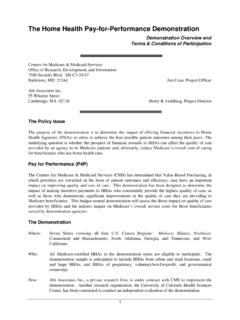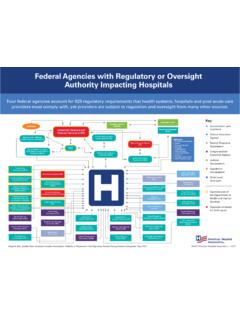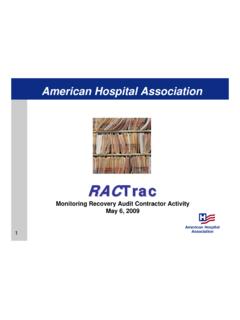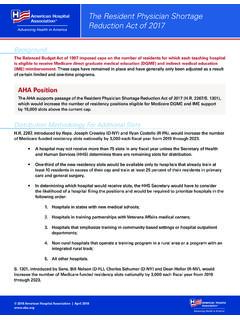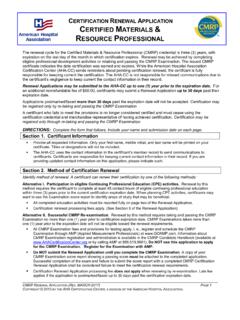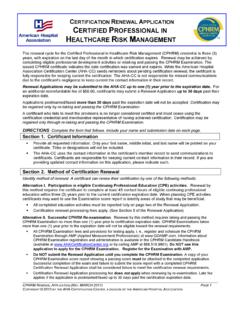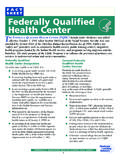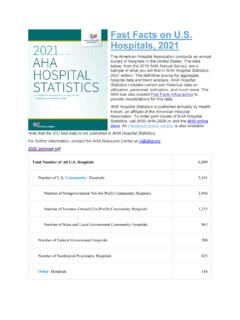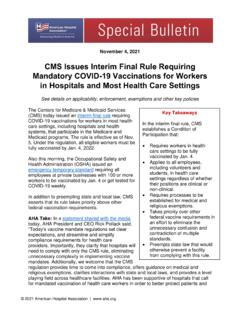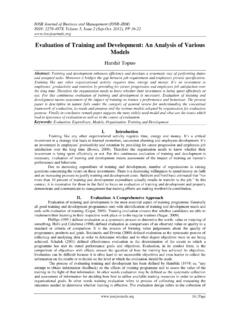Transcription of RURAL REPORT - American Hospital Association
1 RURAL REPORTC hallenges Facing RURAL Communities and the Roadmap to Ensure Local Access to High-quality, Affordable Care2 2019 American Hospital Association | Facing RURAL Communities and the Roadmap to Ensure Local Access to High-quality, Affordable CareNearly 20 percent of Americans live in RURAL areas and depend on their hospitals as important and often only sources of care in their ,2 RURAL hospitals provide access to care close to home and improve the health and well-being of the patients and communities they serve.
2 The availability of local, timely access to care saves lives and reduces the added expense, lost work hours and inconvenience of traveling to facilities farther away. RURAL hospitals also serve as economic anchors in their communities; they provide both direct employment opportunities3 and indirect reinforcement of the local economy through the purchase of goods and services from other private sector The availability of local access to health care is an important factor for businesses considering whether to invest or locate in a particular area.
3 Moreover, private sector employment generated by RURAL hospitals supports a healthy tax base, which funds services such as public education, fire, police and road maintenance. Although RURAL hospitals endeavor to meet the health care needs in their communities, many struggle to address the persistent challenges of providing health care in RURAL America, such as low patient volumes and geographic isolation. At the same time, they are working to manage more recent and emergent challenges, including economic fluctuations, increased regulatory burden, and the opioid epidemic.
4 In response to these difficulties, some hospitals have elected to merge with larger health systems, engage in other types of affiliations or partnerships, or modify their service offerings, in order to stay viable and protect health care access for their communities. In fact, there have been 380 RURAL Hospital mergers between 2005 and 2016, with some RURAL hospitals merging more than While some hospitals are continuing to thrive, others find that the cumulative burden of persistent, recent and emerging challenges threaten their ability to maintain access to services.
5 In fact, the North Carolina RURAL Health Research Program reports that as of December 2018, 95 RURAL hospitals have closed since 2010 (Figure 1). Moreover, the Government Accountability Office reports that more than twice the number of hospitals have closed between These more vulnerable populations are at increased risk of losing access to some types of health care, exacerbation of health disparities and loss of Hospital and other types of local employment. George H. Pink, , Research Fellow, Sheps Center for Health Services Research, University of North Carolina (UNC), as quoted in Health Resources & Services Administration eNews, Hospital closings likely to increase (October 2017)Figure 1: RURAL Hospital Closures Since 2010 December 2018 Source: NC RURAL Health Research Program.
6 (2018). 95 RURAL Hospital Closures: January 2010 Present. The Cecil G. Sheps Center for Health Services Research, University of North Carolina; 2019 American Hospital Association | and 2017 than in the previous five-year period, indicating a worsening These closures stem from numerous factors, including failure to recover from the recession, population demographic trends, ongoing financial struggles and decreased demand for inpatient The effects of these closures vary: in some cases, Hospital closures resulted in a noticeable reduction in a particular set of services ( , elimination of obstetric services or conversion of a full-service acute care Hospital to an urgent care center), while others led to a complete elimination of local access to care.
7 But, in all cases, local residents are put in a position of having to seek alternatives sometimes long distances away to obtain the care they RURAL hospitals, especially those with very limited resources, become overburdened as challenges intensify, accumulate, and compound each other. Moreover, the issues of today may hinder RURAL providers preparedness for the challenges of this REPORT , we examine the persistent, recent, and emergent challenges facing RURAL hospitals and communities; and recommend updates to existing federal policies and areas for new federal investment to support RURAL hospitals and communities to ensure access to high-quality, affordable, and efficient health care.
8 To be sure, the policy environment for RURAL providers is not limited to federal activities; laws and regulations at the state and local levels play critical roles in shaping the RURAL health care context. However, this REPORT focuses on federal policies and investments in light of their nationwide impact and reach. A complete listing of AHA policy priorities and recommendations for America s RURAL hospitals and communities is available in the 2018 RURAL Advocacy Agenda, 2018 Advocacy Agenda, and the Task Force on Ensuring Access in Vulnerable Communities REPORT .
9 All are available at , Recent and Emergent Challenges Facing RURAL CommunitiesRural hospitals have always faced a unique set of circumstances, including a challenging payer and patient mix and geographic isolation. In the 1990s and early 2000s, Congress sought to help account for these circumstances and address the growing number of RURAL Hospital closures by creating several special designations and payment programs the low-volume adjustment, Medicare-dependent Hospital program, and ambulance add-on adjustment, among others which provide enhanced reimbursement under the Medicare program.
10 The designations and programs that remain today are identified and defined in the Appendix. While these programs remain critical to the financial viability of many RURAL hospitals, they no longer provide the financial predictability they once did, and RURAL hospitals continue to grapple with an increasing set of new and ongoing ChallengesLow Patient Volume. Due to low population density in RURAL areas, hospitals lack scale to cover the high fixed operating costs. In fact, as early as 1990, the Government Accountability Office found that Losing an employer of 150 people with good jobs is like losing a manufacturing plant.
